New York's favorite hangdog comic is set to play an actual dog.
Add a CommentViewing: Blog Posts Tagged with: Despicable Me 2, Most Recent at Top [Help]
Results 1 - 20 of 20
Blog: Cartoon Brew (Login to Add to MyJacketFlap)
JacketFlap tags: Feature Film, The Lorax, Despicable Me, Illumination, Chris Renaud, Despicable Me 2, Cinco Paul, Yarrow Cheney, The Secret Life of Pets, Ken Daurio, Louis C.K., Add a tag
Blog: Cartoon Brew (Login to Add to MyJacketFlap)
JacketFlap tags: Penguins of Madagascar, Despicable Me 2, Gravity Falls, Cloudy with a Chance of Meatballs 2, Artist of the Day, Croods 2, Ian Abando, Add a tag
Blog: Cartoon Brew (Login to Add to MyJacketFlap)
JacketFlap tags: UK, Business, Feature Film, Frozen, Monsters University, British Film Institute, BFI, The Croods, Despicable Me 2, Wreck-it Ralph, Add a tag
In 2013, filmgoers in the United Kingdom and Ireland watched more animation than any other type of film, according to a new report by the British Film Institute.
Add a CommentBlog: Cartoon Brew (Login to Add to MyJacketFlap)
JacketFlap tags: Business, Illumination, chris meledandri, Illumination Entertainment, Despicable Me 2, Janet Healy, Mac Guff, Add a tag
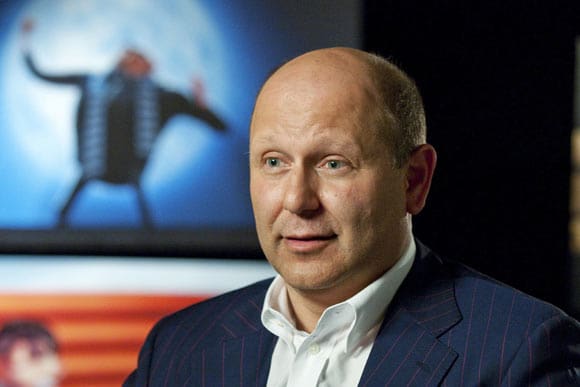
Despicable Me 2 is on track to become the most profitable film in Universal Pictures’ 100-plus year history, and that has turned Illumination Entertainment head Chris Meledandri into the current darling of Hollywood. This Bloomberg Businessweek piece is one of the few things I’ve read about Meledandri’s low-budget approach to feature animation. He pioneered this lower-risk model while he was at Fox, where he was responsible for the Ice Age series, one of the most successful animated feature franchises in history.
“We’re not spending our money on every blade of grass and the leaves on the trees,” says Janet Healy, who is Meledandri’s co-producer. Not only is the production process more restrained, but so is the development process. Illumination picks and chooses exactly what it wants to produce instead of spending money developing numerous pictures that may never move into production. Illumination’s US office has only 35 employees, and though most of the creative work is done elsewhere (particularly Mac Guff in Paris), that’s still a modest corporate structure for a feature animation studio.
Meledandri, like DreamWorks CEO Jeffrey Katzenberg and increasingly John Lasseter at Pixar and Disney, prides himself on the producer-driven approach to filmmaking. He mentions in the article that there is never any dissent because he oversees creative approvals on a daily basis: “There is never a situation where a production proceeds down a path only to discover those with ultimate creative authority aren’t in agreement.” The strategy has worked exceedingly well for him so far, though the strategy isn’t always clear, even to those who work with him. “I think he’s got a vision,” says his co-producer Healy. “I just don’t know what it is.”
Add a CommentBlog: Cartoon Brew (Login to Add to MyJacketFlap)
JacketFlap tags: Business, Ideas/Commentary, Feature Film, Brad Bird, Jeffrey Katzenberg, Despicable Me 2, Chris Melendari, Richard Verrier, Add a tag
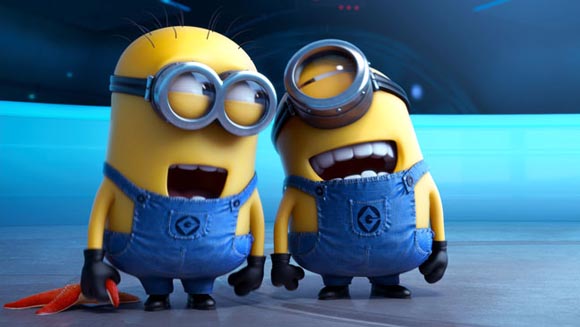
Well, it’s that time of year again. A couple animated films perform below-average at the box office and the mainstream media begins asking, “Are Hollywood studios cranking out too many animated films?”
The article is filled with alarmist descriptions of the film animation industry, like “a flood of computer-animated movies” (because five films apparently constitutes a ‘flood’) and eye-roll worthy quotes like this one from DreamWorks CEO Jeffrey Katzenberg:
“We’ve never experienced this level of animation congestion in a period of time.”
and this gem from Illumination chief executive Chris Meledandri:
“[A]s more films are planned, it’s inevitable that there will be more acute cannibalization of each other.”
Cannibalization? Let’s get a grip, here. There are only eleven major animated releases planned for this year. That’s compared to hundreds of live-action releases. How is it that the feature film market can support hundreds of live-action films but less than a dozen animated pics?
The problem isn’t that there are too many animated films; the problem is that every single animated release is targeted at the same family demographic.
Yes, there were five animated releases this summer in the span of a couple months. That’s hardly newsworthy considering that there were dozens of live-action releases in the same period. The issue is that all five of those films were targeted to the exact same audience. I suffered through a couple of them, and if you have an intellectual capacity beyond a seven-year-old’s, chances are you’re going to want to watch something more stimulating.
A far more illuminating article would have been to ask why film executives ghettoize the animation art form and refuse to cater to a broader range of audiences, as animated filmmakers in Europe and Asia routinely do. Hayao Miyazaki’s controversial new animated feature The Wind Rises is geared toward adult audiences, and has not only been the number one film in Japan for the past month, but will likely become Japan’s number one film at the box office for all of 2013.
The writer of the LA Times article, Richard Verrier, who should know better considering that he covers the film industry for a living, erroneously refers to animation as a genre in his piece on multiple occasions. But, as we’ve discussed many times before, animation is NOT a genre. It may be perceived as a genre by Hollywood execs, but animation is as much a genre as live-action is.
To quote the animation industry’s patron saint of common sense, Brad Bird:
I think that there is more misreading of trends in animation than any other of the film community. If Cool World fails, then all adult-themed animation is doomed. And if Disney fails, all of animation is doomed. And it’s not like, “Well, hey, man, you know, maybe people are tired of five songs and a familiar story.” … That’s like if George Lucas hit a rough patch, somebody would suddenly say, “Well, people are tired of science fiction.” It’s ridiculous! It’s the kind of idiotic statement that never seems to go out of style in Hollywood… Animation is not a genre. It is a method of storytelling. People are constantly analyzing it and misanalysing it as if it is a genre. It isn’t a genre. It can do horror films, it can do adult comedies if it wanted to, it could do fairy tales, it could do science fiction, it could do musicals, it could mystery, it can do anything. Because Disney has been the only one that’s lavished any care on it, people [then] think it’s the only kind that can be told successfully.
And even if you want to lump all animation as a genre, the argument is still flimsy and incorrect. How is there a glut when two of the top four films at the American box office are animated this year:
- Iron Man 3 / $408,195,474
- Despicable Me 2 / $346,642,075
- Man of Steel / $289,694,329
- Monsters University / $261,134,998
- Fast & Furious 6 / $238,464,720
On top of that, Despicable Me 2 is the single most profitable film in the history of Universal. The financials alone would suggest that the success rate in animation is far higher than live-action’s hit rate. Perhaps then, the writers of the LA Times should be exploring whether there’s a glut of live-action films in Hollywood.
Add a CommentBlog: Cartoon Brew (Login to Add to MyJacketFlap)
JacketFlap tags: Planes, Turbo, Smurfs 2, Monsters University, Despicable Me 2, Box Office Report, Add a tag
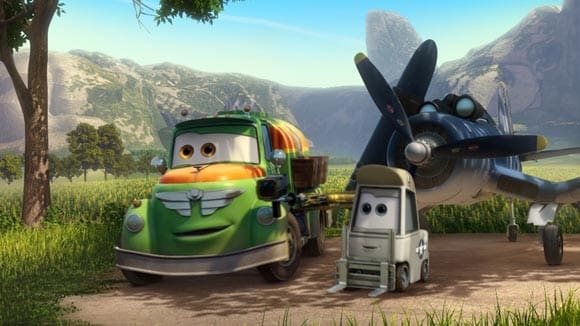
No new animated films opened last weekend, but there was plenty of animation in the theaters. Here are the estimated earnings of animated films in US theaters:
5th: Planes / $13.1 mil WEEKEND / $45.1 mil TOTAL
9th: Smurfs 2 / $4.6 mil WEEKEND / $57 mil TOTAL
12th: Despicable Me 2 / $3.8 mil WEEKEND / $346 mil TOTAL
16th: Turbo / $1 mil WEEKEND / $77.6 mil TOTAL
Internationally, the box office played out like this:
Smurfs 2 / $20 mil WEEKEND
Despicable Me 2 / $19.5 mil WEEKEND
Planes / $7.3 mil WEEKEND
Monsters University / $6 mil WEEKEND
Turbo / $2.9 mil WEEKEND
And the overall box office totals to date (US plus international):
Despicable Me 2: $781.2 mil
Monsters University: $658.6 mil
Smurfs 2: $207 mil
Turbo: $142 mil
Planes: $52.4 mil
Blog: Cartoon Brew (Login to Add to MyJacketFlap)
JacketFlap tags: M, Hayao Miyazaki, Illumination, Smurfs 2, Monsters University, Despicable Me 2, Box Office Report, Kaze Tachinu, The Wind Rises, Raja Gosnell, Add a tag
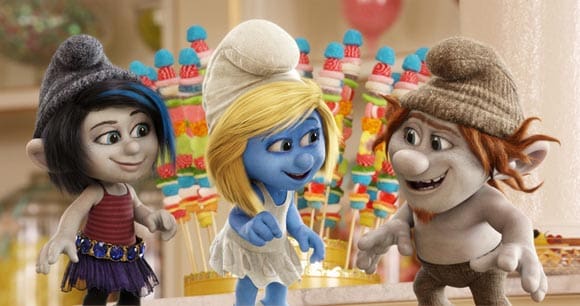
In spite of a soft third-place opening in the United States, Sony’s Smurfs 2, directed by Raja Gosnell, managed to become the number one film globally last weekend. The film opened with just $17.5 million in U.S. theaters, but made up for it with $52.5 mil in over forty international markets. Even with the strong overseas opening, the film is unlikely to top the original Smurfs worldwide gross of $563.7 mil.
Illumination’s juggernaut Despicable Me 2 scored $10.1 mil in its fifth U.S. weekend, boosting its domestic cume to $326.4 mil. It also added $13.8 mil internationally, and after last weekend, its global gross is $716.7 mil. It is the third highest-grossing movie of the year so far, trailing only Iron Man 3 and Fast & Furious 6. Disney’s Monsters University earned $1.4 mil domestically and $11.4 mil internationally. Its global total is $613.5 million through last weekend.
In Japan, Hayao Miyazaki’s Kaze Tachinu (The Wind Rises) held onto the top spot in its third week of release. The film grossed $5.6 mil from 454 screens, and has a Japanese box office total of $44.3 mil.
Add a CommentBlog: Cartoon Brew (Login to Add to MyJacketFlap)
JacketFlap tags: Ideas/Commentary, dreamworks, Turbo, DreamWorks Animation, Monsters University, The Croods, Despicable Me 2, Box Office Report, Add a tag

The Wall Street Journal published a story last weekend about Hollywood’s struggle to recoup its costs on big-budget tentpole films, but there’s one bright spot the WSJ (along with the rest of the mainstream media) always fail to recognize and that’s that animation is more successful than ever before.
Despite Turbo’ stumble at the box office and Henry Selick’s diss that American animated films are all the same, audiences around the world can’t get enough of big-budget CG animated features. Check this out:
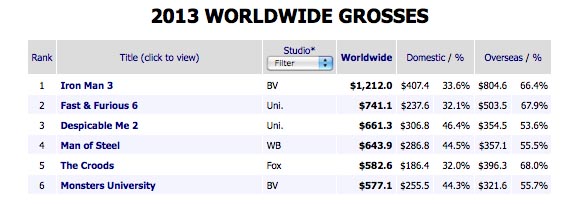
Only six films have grossed $500 million dollars or more at the worldwide box office in 2013, and three of those films are animated. Let’s put this into perspective: animation studios have released just five animated features this year with a production cost of over $75 million and three of those films became half-billion grossers; on the other hand, live-action filmmakers have released over 20 films this year that cost $75 million or more, and only three of those films have achieved a similar mark. The evidence is clear: expensive animated tentpoles have a much better chance of being profitable than their live-action counterparts.
Leading the way amongst animated films at last week’s box office was the mega-hit Despicable Me which landed in 3rd place with $16.4 mil in its fourth U.S. weekend, boosting its domestic total to $306.8 mil. The film added $24.5 mil from foreign markets for an overseas total of $354.5 mil.
Monsters University continued a similarly strong run, earning $2.9 mil in its sixth U.S. weekend and $15.6 mil from overseas. The film’s totals are now $255.5 mil domestically and $321.6 foreign. The film has yet to open in markets like China and Italy, and by the time it’s all over, the film should become Pixar’s fourth highest-grossing movie ever.
The only animated clunker in theaters right now is DreamWorks’ Turbo, which had a sophomore frame gross of $13.7 mil, good enough for fourth place and a U.S. total of $56.2 mil. The film had a slim 35.5% decline, but it was slim only because the film couldn’t decline much further from its already meager opening weekend. Turbo managed to pick up $12.5 mil from 30 overseas markets pushing its foreign total to $41.9 mil. After two weekends, the film’s combined gross is $98.1 mil.
More animation is coming soon, too. Sony’s Smurfs 2 will be released this week, and Disney’s Planes next week.
Add a CommentBlog: Cartoon Brew (Login to Add to MyJacketFlap)
JacketFlap tags: Pixar, dreamworks, Turbo, DreamWorks Animation, Illumination, Illumination Entertainment, Monsters University, Despicable Me 2, Box Office Report, Add a tag
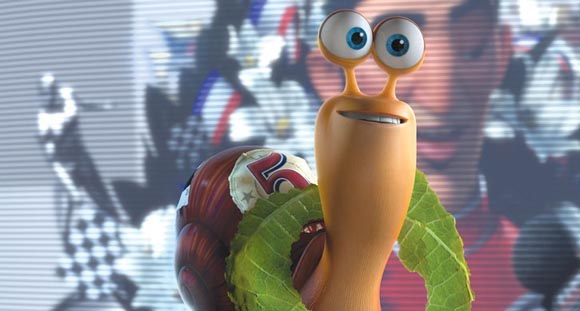
Turbo, the DreamWorks-produced and David Soren-directed animated feature about the snail that could, opened in a disappointing third place in the U.S. with an esimated $21.5 million. The film is the third-lowest all-time opening weekend for a DreamWorks CGI film, doing better than only Antz (1998) and the Aardman-produced Flushed Away (2006). However, adjusted for inflation and 3D prices, Turbo had the smallest opening weekend audience EVER for a DreamWorks CG pic. The film has grossed $31.2 million since opening last Wednesday.
Illumination’s Despicable Me 2 kept up its amazing run in its third weekend. The film landed in second place with an estimated $25.1 million. Its current domestic total is a smashing $276 million, and by next weekend it will pass Man of Steel to become the second-highest grossing film in America this year. Holding up the tenth place spot was Pixar’s Monsters University, which earned an estimated $5 million in its fifth weekend. The film’s total now stands at a robust $249 million.
International numbers to come in a bit.
Add a CommentBlog: Cartoon Brew (Login to Add to MyJacketFlap)
JacketFlap tags: Illumination, Monsters University, Despicable Me 2, Box Office Report, Add a tag

The audience pleasers Monsters University and Despicable Me 2 have now resulted in fully-animated features leading the U.S. box office for four straight weeks. Despicable Me 2 retained its number one slot this weekend while facing stiff competition from two newcomers—Grown Ups 2 and Pacific Rim. The modestly budgeted Illumination film grossed an estimated $44.8 million over the 3-day span, boosting its overall total to $229.2M.
To put this into perspective, the last time that fully-animated features led the U.S. box office for four weeks or longer was nearly twenty years ago, when Toy Story was the number one film for six straight weeks in 1995.
In its fourth weekend, Monsters University landed in sixth place, grossing $10.6M for a $237.8M domestic cume. International figures for these films coming soon.
Add a CommentBlog: Cartoon Brew (Login to Add to MyJacketFlap)
JacketFlap tags: Feature Film, Steve Moore, Despicable Me 2, Eric Guillon, Maël Gourmelen, Michael Defeo, Yarrow Cheney, Add a tag
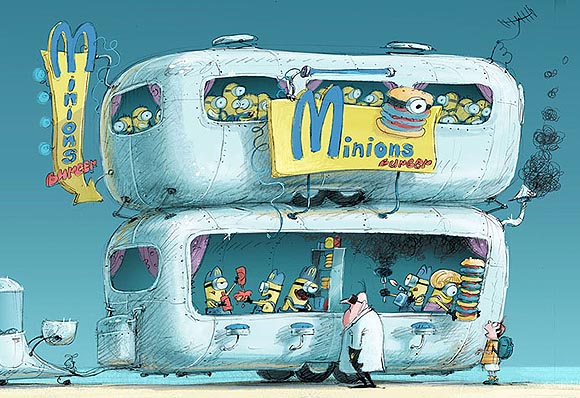
For all of its success at the box office, Despicable Me 2 lacks something that nearly every other major animated film has: an ‘art of/making of’ book. Those of us who want to get a better look at the film’s development and concept art have to scour the Internet for whatever bits and pieces we can find. To help make that job easier, I’ve pulled together some sites and videos that feature artwork from the film. If you have others, please share them and we’ll compile our own online ‘art of’ book.
The video above, filmed at an exhibition of the film’s artwork at Galerie Arludik in Paris, features comments from art director Eric Guillon, production designer Yarrow Cheney, and character development artist Michael Defeo.
Guillon, who is credited as the designer of the Minions, recently started posting some of his super-appealing development art on his personal blog. He should be doing illustrated book tie-ins for the films.
Storyboard artist Steve Moore is interviewed about his contributions to the film at the Flip animation blog. (Moore is also the director of the cult Disney short Redux Riding Hood.)
Character designer Maël Gourmelen has dedicated a post on his blog to posting his character concepts for the film.

Blog: Cartoon Brew (Login to Add to MyJacketFlap)
JacketFlap tags: Ideas/Commentary, Aladdin, Tom Hanks, Robin Williams, Owen Wilson, Benjamin Bratt, Cameron Diaz, Chris Renaud, Al Pacino, Despicable Me 2, Pierre Coffin, Chris Melendandri, Add a tag
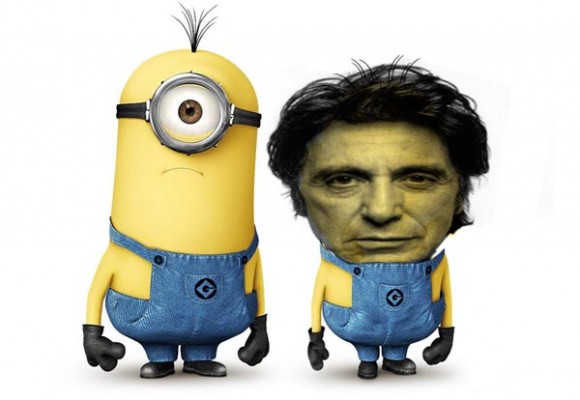
Among the juicier dramas surrounding the production of the megahit Despicable Me 2 is Al Pacino’s sudden departure from the film. Six weeks before the film’s premiere at Annecy, Pacino quit the film as the voice of the antagonist El Macho. Neither side will say what happening, simply citing ‘creative differences.’
At that point, the production was nearly finished and the animation had already been locked. This sent Illumination head Chris Meledandri scrambling to find a replacement, which turned out to be Benjamin Bratt. Since no new animation could be created at that late stage, Bratt re-recorded the dialogue by matching the existing animation, and in true Hollywood fashion, they fixed it all in post.
The controversy serves as a perfect case study for one of the long-running debates in the animation world, which is whether celebrities make any box office impact on the success or failure of an animated feature.
Back in the early-1990s, when Robin Williams provided the voice of the Genie in Aladdin, he earned scale pay for his performance, which was less than $100,000, so it hardly mattered whether celebrities affected the bottomline. But today, celebrities demand lucrative fees for their voices and drive film budgets up by tens of millions of dollars. Owen Wilson took home $2.5 million for Cars 2, Cameron Diaz had a $10 million payday for Shrek Forever After and Tom Hanks earned a reported $15 million for Toy Story 3.
What would happen if you took a celebrity out of one of these films? Would audiences still show up? That’s exactly what happened with Despicable Me 2. The result? It was the fourth-biggest opening ever for an animated feature in the United States.
Those who create animation know the reality: audiences don’t go see animated features because Al Pacino is in it. They go see animated films because they want to be entertained, and the quality of the animation performance and storytelling are far bigger factors than who voices any particular character. The most popular characters in Despicable Me 2, the minions, are voiced by two no-name French actors—Chris Renaud and Pierre Coffin. They’re not well known actors because they were the directors of the film.
The celebrity culture of animated features won’t change anytime soon. Studios believe that they derive benefits from having A-listers in films because audiences love celebrities. But there’s no empirical evidence that audiences are attracted to famous voices in the same way that they are attracted to seeing those actors in the flesh.
Still, celebrities do play one hugely important role in the animation process. They pad the egos of fragile animation executives who would otherwise be embarrassed to tell people they produce animation. At Hollywood parties, these execs can tout to their friends that they, too, are working with A-list Hollywood stars. Because after all, who would want to tell their friends that the stars of their hit film is two French dudes named Chris Renaud and Pierre Coffin?
Add a CommentBlog: Cartoon Brew (Login to Add to MyJacketFlap)
JacketFlap tags: Illumination Entertainment, Monsters University, Chris Renaud, Despicable Me 2, Box Office Report, Pierre Coffin, Add a tag

For the third week in a row, an animated film has taken the crown at the U.S. box office. This week, the winner is Illumination Entertainment and Universal’s Despicable Me 2. The Pierre Coffin and Chris Renaud-directed film scored an estimated $82.5 million over the weekend, and since its debut last Wednesday has earned a massive $142.1 million. The film’s three-day opening was nearly identical to the opening of Disney/Pixar’s Monsters University, however, Despicable Me cost a reported $76 million to produce, whereas the Pixar film cost closer to $200 million. Overseas grosses on Despicable Me 2 are still to come, but Box Office Mojo reports that the film has already made over $150 million overseas, and Deadline Hollywood says the film opened in first place in 35 of its 38 new markets and set the following records:
Territory highlights/records: biggest opening ever for an animated film in Indonesia, Mexico, South Africa, Trinidad and Vietnam; highest opening day ever for all films in South Africa; Universal’s biggest opening day ever in Brazil, Hungary, Mexico and South Africa; third biggest opening day ever in Mexico just behind Iron Man 3 and The Avengers.
The biggest story here is that Despicable Me 2 is performing as well as any Pixar/DreamWorks CG tentpole on a fraction of the budget. The other studios throw money at their films, but the producers of Despicable Me 2 focused on delivering the best entertainment bang for the buck.
With the new competition in the kiddie film market, Monsters University took an expected hit in its third weekend, dropping 57% for an estimated take of $19.6M. The film, which landed in fourth place, has grossed a solid $216.1 in the United States. Combine that with $184.4M overseas, and it has now crossed the $400M mark worldwide.
Add a CommentBlog: Cartoon Brew (Login to Add to MyJacketFlap)
JacketFlap tags: CGI, Feature Film, Talkback, Illumination, chris meledandri, Illumination Entertainment, Chris Renaud, Despicable Me 2, Pierre Coffin, Add a tag

Despicable Me 2, which debuted in the United States on Wednesday with a mammoth $34.3 million, is headed into what is guaranteed to be a huge opening weekend. The film is the fourth effort from Illumination Entertainment, the studio run by Chris Meledandri, who is the former 20th Century Fox Animation president responsible for films like Ice Age and Horton Hears a Who!.
Critical reaction to Despicable Me 2, directed by Pierre Coffin and Chris Renaud, has been decent though not spectacular, which is quite similar to another recent animated follow-up, Pixar’s Monsters University. The critics’ rating on Rotten Tomatoes stands at 75% with an audience rating of 89%. Variety labeled the film an “endearing if slightly less inspired sequel,” while the NY Times stated that it was “consistently diverting and so cute you’ll want to pet it” while cautioning that “it is also weightless and lacks a center.” The note sounded by most critics is that it’s ultimately a likeable film, as summed up by the Village Voice: “It’s breezy and affable without ever going completely soft.”
And now it’s your turn. After you see the film, report back here with your thoughts in the comments below. As always, this talkback is reserved for readers who have seen the film and wish to share their views with others in the animation community.
(Despicable Me 2 billboard via Daily Billboard)
Add a CommentBlog: Cartoon Brew (Login to Add to MyJacketFlap)
JacketFlap tags: Ideas/Commentary, Feature Film, Universal Studios, Despicable Me, Illumination Entertainment, Despicable Me 2, Cinco Paul, Despicablimp, Add a tag
Leading up this week’s release of the sequel, Despicable Me 2, the minions are the center of an inescapable advertising bonanza, overshadowing even the human characters in the film. The yellow pill-shaped creatures are on billboards, bus ads, and commercials. They have their own upcoming attraction at Universal Studios Hollywood (they’re already at Universal Orlando), themed hotel suites, video game and a feature-length prequel set for a 2014 release. And then there’s the Despicablimp, a 165-foot-long, 55-foot-tall airship which is currently on a six-month, 20,000-mile journey across the United States to promote the film.
No longer the background entertainment, the minions are the cornerstone of the marketing plan for Despicable Me 2, starring in nearly every ad for the film. Their success among audiences surprises even the film’s writers. “We never knew the minions were going to be so popular; it just became a force of nature,” said the film’s co-writer Cinco Paul in an interview with the Los Angeles Times. The bumbling gibberish and clumsy nature of the minions easily translates across cultures and age groups to win over fans. The minions have also tapped into the striking power of yellow, a color that has found wide recognition in animation and entertainment.
We’ve seen large groups of secondary characters become unofficial film mascots in the past—the aliens from Toy Story and the penguins from Madagascar were breakout stars from their respective films. Hordes of animated characters were a rarer sight when hand-drawn animation was the preeminent feature film technique, but with computer animation, it is easy to replicate and tweak models to achieve a cast of many. The relative ease with which the makers of Despicable Me 2 have created their army of minions would’ve made the 101 Dalmatians animators cry with joy.
The Los Angeles Times recently published an article on the success of the minions, which twice praises the characters’ simple design and says that even children can draw them. But it’s more than just the “simple, graphic nature” of the minions that makes them a success with audiences. Their childlike mannerisms and brazen stupidity is a brand of humor that translates to almost any demographic. Their giggles and gibberish, though annoying to some, is downright infectious.
Even though they risk overexposure, the minions could become a coveted marketing model for animated features, and it won’t be surprising if other studios attempt to copy the formula. But this could result in derivative forms that feel superficial, especially if the characters’ personalities aren’t developed with care. The minions’ push to the forefront grew organically from audience response to the first film. Perhaps then, the real lesson here is that even in this modern era of sequels, prequels, spin-offs, remakes and adaptations, audiences still value and reward original creations.
Add a CommentBlog: Cartoon Brew (Login to Add to MyJacketFlap)
JacketFlap tags: Feature Film, Making Of, Steve Carell, Despicable Me 2, Add a tag
It’s always fascinating to see how the animation process is explained to the general public. Here’s the latest example: actor Steve Carell, who was last seen dressed as a cartoon character, talks about the making of Despicable Me 2.
Add a CommentBlog: Cartoon Brew (Login to Add to MyJacketFlap)
JacketFlap tags: Advertising, Feature Film, Ellen DeGeneres, Steve Carell, Despicable Me 2, Gru, The Ellen DeGeneres Show, Add a tag
Here’s a new way of promoting an animated movie: having a voice actor dress up as their character for a talk show appearance. That’s what Steve Carell did on The Ellen DeGeneres Show last week when he appeared as Despicable Me 2′s Gru.
(Thanks, Jen Hurler, via Cartoon Brew’s News Submission Forum)
Add a CommentBlog: Cartoon Brew (Login to Add to MyJacketFlap)
JacketFlap tags: CGI, Feature Film, Illumination, Despicable Me 2, Add a tag
A new trailer released today for Illumination Entertainment’s Despicable Me 2 directed by Pierre Coffin and Chris Renaud:
Add a CommentBlog: Cartoon Brew (Login to Add to MyJacketFlap)
JacketFlap tags: Feature Film, Despicable Me 2, Add a tag
In case you were wondering whatever happened to the idea of animated shorts in movie theaters before the main feature: they still exist as two-minute (or less) trailers. Here’s the latest “Minions” short promoting the release of Despicable Me 2, directed by Pierre Coffin and Chris Renaud, opening in theaters on July 3, 2013.
Add a Comment
Blog: Cartoon Brew (Login to Add to MyJacketFlap)
JacketFlap tags: Feature Film, Despicable Me 2, Add a tag
This is what you’ll see when you attend The Lorax this weekend. Should look good in 3D.
Cartoon Brew |
Permalink |
No comment |
Post tags: Despicable Me 2




